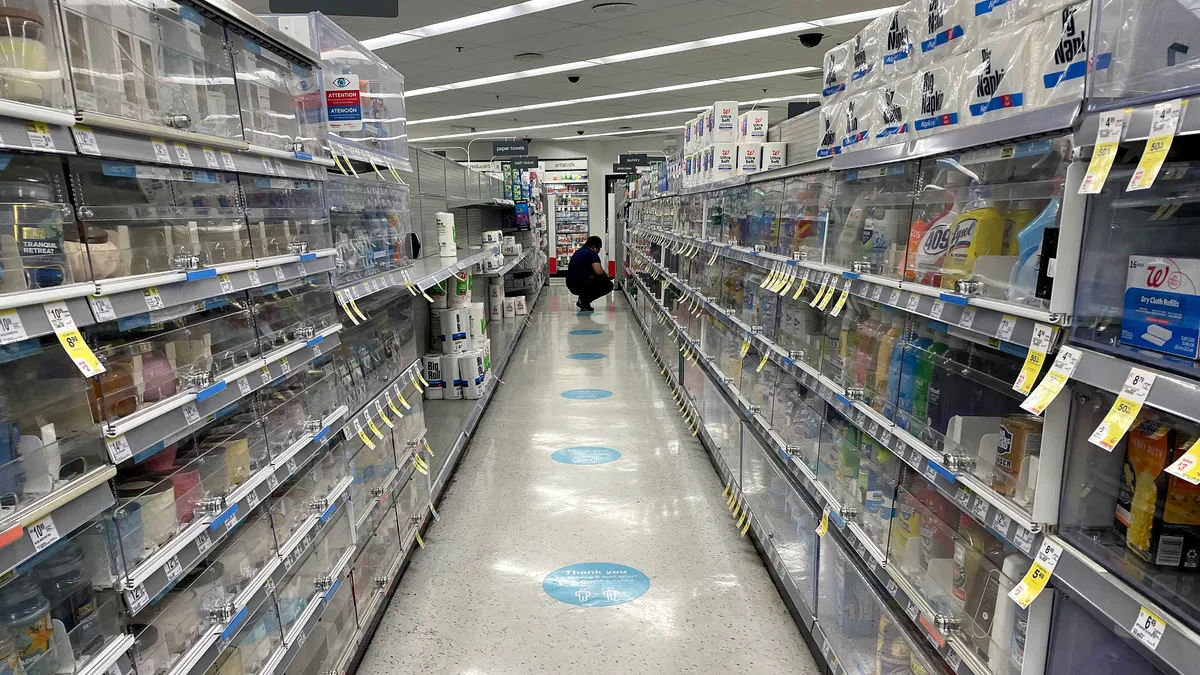A familiar sight has emerged at retailers of all shapes and sizes. From big box stores to pharmacy chains, consumers are encountering shelves filled with household goods locked behind glass.
Even seemingly innocuous goods, like deodorant or laundry detergent, can require a store associate to retrieve.
More and more retailers are locking products inside cabinets to prevent theft. While this approach can thwart would-be thieves, it can also frustrate customers who have to wait for assistance to access common products.
Theft prevention doesn’t have to come at the cost of customer experience. A combination of smart staffing practices and carefully applied technology can form a better deterrent than putting products under lock and key.
“Good customers come in, they see that wall of glass and no employees within 100 miles, and they say, ‘You know what? I'm just going to order this on Amazon,” said Brand Elverston, founder and principal of Elverston Consulting and a former Walmart executive.
Security cabinets don’t always work, and can have a negative impact on margins. Thieves still have ways to nab locked up items, while honest shoppers will take their business elsewhere, experts told sister publication CX Dive.
A good theft prevention strategy starts by mapping out specific challenges and goals, according to Kassi Socha, director analyst of marketing at Gartner. She encourages executives to implement an approach and balance particular to their companies and to refrain from copying a strategy just because it worked for another company.
“Retail leaders can move forward in changing the customer experience to address shrink, but that execution should never come before actually understanding the impact of shrink on the business as a whole,” Socha said.
Attentive associates thwart criminals
Retailers can improve customer experience and deter thieves at the same time by having more workers on the floor.
Associates can’t stop truly determined and organized thieves altogether, according to Elverston. However, a majority of would-be criminals can be stopped by a helpful worker simply walking up and asking if they need help finding something.
“Crooks don't like attention,” Elverston said.
Many retailers reduced their headcount in the wake of the pandemic, but a return to higher staffing levels can become a differentiating factor for retailers to attract customers and build loyalty.
“It isn't going to be too long before what was old is new again, and that a headline for a retailer is going to be, ‘We have people,’” Elverston said.
More workers don’t automatically create a better experience, according to Socha. Employees need tech and training to offer the attentive service that drives customer experience while dissuading would-be thieves.
“The best retailers are investing in technology to support and empower frontline associates at the same time [they’re] investing in training and development to ensure their frontline associates know how to use the new tech or know how to operate in the new store experience,” Socha said.
Designing a labor strategy that maximizes the in-store experience while minimizing shrink is a cross-department effort, Socha said. CX leaders can join with finance, human resources and other executives to ensure workers are efficiently trained and equipped.
Cameras and AI work well together
Many retail stores already have security cameras in place. Computer vision, computers trained by AI to identify and track items and people, can tap into these existing networks to detect suspicious activity more effectively than a human could.
AI-powered theft solutions detect actions commonly associated with theft, such as a customer hiding items in their cart, and can notify staff if needed, Elverston said. This lets them deter crime without impacting honest customers’ shopping experience.
Home Depot is taking this approach to its self-checkout queues. The retailer uses computer vision to identify shopping carts containing high-value or complex combinations of items, executives said during a May earnings call.
Once triggered, Home Depot’s system will call over an associate to assist the customer and ensure all items are scanned and accounted for. This can help legitimate customers check out faster while stopping would-be thieves, executives said.
Computer vision carries other customer experience benefits as well, Elverston said. While watching for thieves, cameras can also point out spills and other hazards before they trip up customers.
As the cost of AI-powered surveillance drops, it may become more attractive. The money saved by reducing theft can offset the cost of getting the network running.
“It's less expensive than payroll, and I hate to say it, but it never takes a break,” Elverston said. “It never updates its Facebook. It’s never texting. It's 24/7 eyes on the target.”
AI isn’t a replacement for the human touch, however. Different retailers will balance the use of workers and technology in their own way. Smaller companies with only a few stores may find it less expensive to pay for extra labor, for example. This approach also supports a customer experience that focuses on being local and human-centric with helpful associates that know their customers, Elverston said.
On the other hand, bigger companies will likely favor a strategy that leans into AI-powered cameras. A retail chain with thousands of stores would need to spend a correspondingly large amount on labor costs — making hardware acquired in bulk a more attractive investment, Elverston said.
























